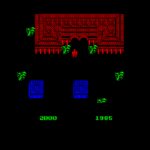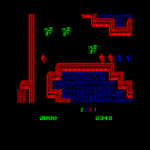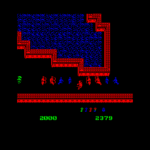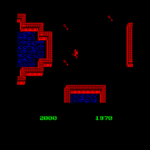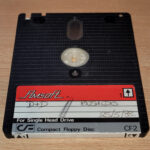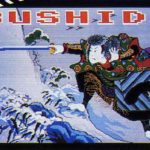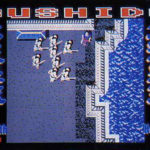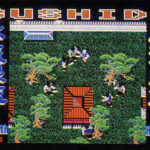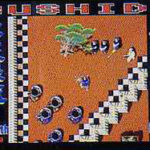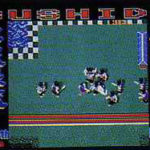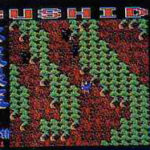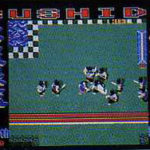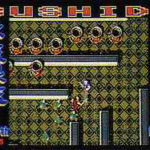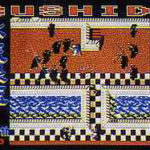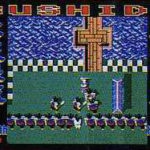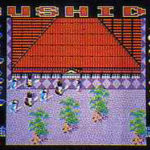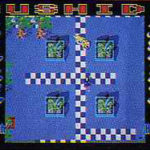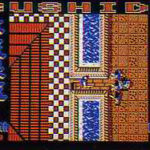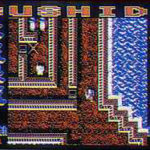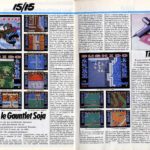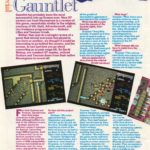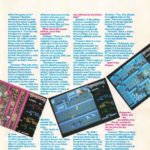1988 Ariolasoft / U.S. Gold
Platform: Atari ST, Commodore Amiga, PC, Amstrad CPC, ZX Spectrum and Commodore 64
Bushido Warrior (or potentially just Bushido) was a new oriental themed Gauntlet clone that was due out for a wide number of platforms, published by Ariolasoft/U.S. Gold. The Commodore 64 edition is already well documented via our GTW64 page.
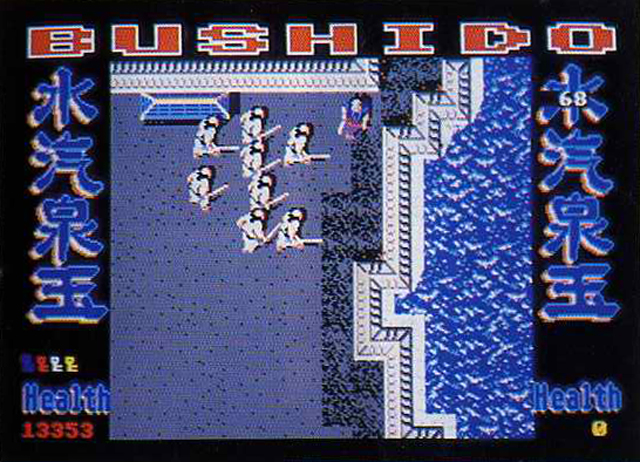
Although a Gauntlet clone, it was more than just a clone – and it seems that the entire 16-bit editions may have been based off the Gauntlet conversion codebase. Computer and Video Games magazine spoke with the ST developers, Graham Lilley and Teoman Irmak in August 1987.
At the end – they were asked what their plans were next, and Teoman responded:
“We’re working on a new arcade game, also for the ST, called Bushido which is Japanese for ‘the way of war making’. It should be finished sometime in the autumn and will again be published by Adventure Soft.”
We knew for years that Bushido/Bushido Warrior was a Gauntlet clone thanks to Gary Yorke, who in 2006 confirmed that himself and James Poole were overseeing the developments of the game for Ariolasoft. Patricia Curtis then later confirmed her involvement with the C64 edition, though didn’t recall interacting with Gary/James at all.
Sadly Patricia (and artist Stephen Hall) confirmed no longer having anything of the development, though when meeting Patricia at Crash Live 2023, she revealed that screenshots of the game had been published in a French magazine called TILT in 1988. She fired over the scan in question.
As you can see from the gallery, the game is clearly a Gauntlet clone and could well have been based upon the ST code of the original arcade conversion done by Graham and Teoman. Surely it cannot be a co-incidence, what with it being from around the same time, the Gauntlet links and the U.S. Gold links? Unfortunately the article did not name any developers, but it go into some details about the game itself.
The game was described as an arcade/adventure game where you must save four princesses imprisoned against their will. Obeying the Bushido code, the samurai code of chivalry, you volunteer to rescue these famous prisoners.
You would be able to choose between two samurai (or play together with two players) in the form of Ven-uf and Ming-pu. The latter is a specialist in throwing shurikens, and the other at throwing knives. Both also have a samurai sword which can be used in hand-to-hand combat.
Starting off in a garden and where a superbly animated tiger walks past peacefully, you have to explore around 104 levels to try and find the princesses. Doors and stairs are found on all levels, where some doors can only be opened with keys of a certain colour. Opening chests will enable you to gain magical powers, to increase your strike force or your endurance. As with Gauntlet, there is also food dotted around to improve your health.
Dotted around are also magic flags. Red flags increase your combativeness, green flags allow you walk through walls, blue flags increase your life points and yellow flags give you the possibility of changing positions by placing your opponent elsewhere on the map (useful when an enemy is blocking a path).
Then there are the pots. Large ones contain food and keys, small red pots freeze opponents for a few seconds and green pots can reverse certain actions (i.e. eating food makes you lose life points, whilst hits increase them!). Using magic, you can summon four warriors (Junshi) to fight alongside you for a brief period. On top of this, there would be a variety of enemies in the form of ronins, samurai, soldiers and more.
TILT seemed to see a working demo at the time, where they described there being excellent animation, good multi-directional scrolling and a very pleasant burst of colours. Interestingly, its mentioned that the intro music was by the group INXS, though its not clear if this was temporary and not officially included at the time. Overall, the game sounded like (and looked like) an impressive build upon the Gauntlet engine.
The game was slated for release in October 1988, but of course would never happen. Perhaps Atari were not happy with how close it was to Gauntlet? Or were there other issues still yet to be uncovered? Patricia suggests that they sent the completed game (C64) to Ariolasoft, but the company collapsed before it could be released.
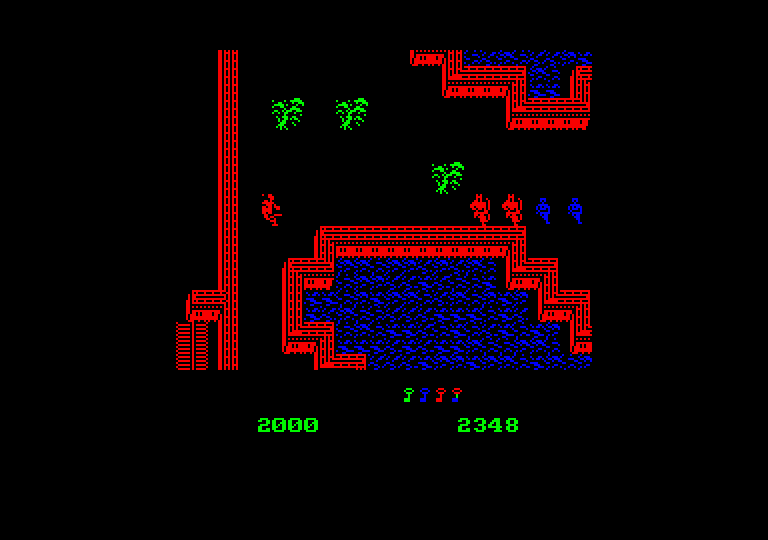
Were any other conversions under way at the time as well as the ST and C64 ones? Well – yes! Dave Semmens was the developer of the ZX Spectrum edition of the game for Source The Software House, as was Laurie Sinnet for the Amstrad CPC.
Although the developers got paid and the games were complete, the collapse of Ariolasoft meant they would never see the light of day either. Interestingly, the ZX and C64 versions shared the same map data (Dave taking the 100 C64 maps and converting), though Laurie created his own 100 maps from scratch in his own editor according to Dave. Sadly Dave no longer has anything of his conversion, and we’re yet to get hold of Laurie.
When searching old emails to see if I had spoken to Dave Semmens in the past, I found an old email from Martyn Carroll (ex-Retro Gamer editor, and now regular writer) in 2011 which referred to the Mega Twins disks that had surfaced around that time and was briefly put up for auction by David Powell, and said the following:
In the recent Mega Twins auction, the same seller listed another game titled Bushido. Obviously this is the unreleased Bushido Warrior. I spoke to coder Ross Harris (who was involved at Source) and he said: “The game was shelved because the publisher Ariolasoft went bust. I just got an IM from Dave Semmens the ZX programmer and he reminded me how they were a little upset that one of our maps (it was a Gauntlet style clone) had no exit. As he had converted the maps verbatim from the C64 he had to point out that then the Commodore version had the same problem!” Though you might find that interesting.
This was something I’d completely forgot about. At the time, I had assumed that the title would make its way into the public domain in the same way as Mega Twins did. We were only interested in finding the C64 edition.
I got in touch with David Powell to find out more, and he confirmed that Steve Brown from the TZX Vault had obtained and preserved all the disks. Upon checking, Steve had indeed preserved the disk, but the disk was coming up as corrupted in Disk Image Manager. He very kindly passed on copies of the backups made.
Setting up WinAPE with standard Amstrad settings, remains of Bushido ran first time, and present on the disk was an early’ish demo with quite a large map to explore, but no sounds and a few glitches in places. But it was crucially playable, and something playable of a game not seen for over 30 years. Also on the disk was an early build of Heroes of the Lance, which was nothing to do with Source The Software House, so its likely someone at U.S. Gold and copied the files onto a single disk.
We don’t believe this is the final version of the game, as it sounds like the title was fully complete. Hopefully in the future, more will come to light, but this is a great finding as a starting point. There is a remote possibility that some of the other disks (unlabelled) will have something more of the game, and possibly even of the ZX Spectrum edition – so we keep our fingers crossed for when Steve gets a chance to take a look at them again.
With a huge thanks to Steve Brown for preserving the CPC edition and photo of the disk, Martyn Carroll for the original heads up about the auction, David Powell for originally saving the disks from a bootfair in 2011, Patricia Curtis for highlighting the scans, Dave Semmens for info about the ZX + CPC versions, and Abandonware magazines for the hi-res scan.
